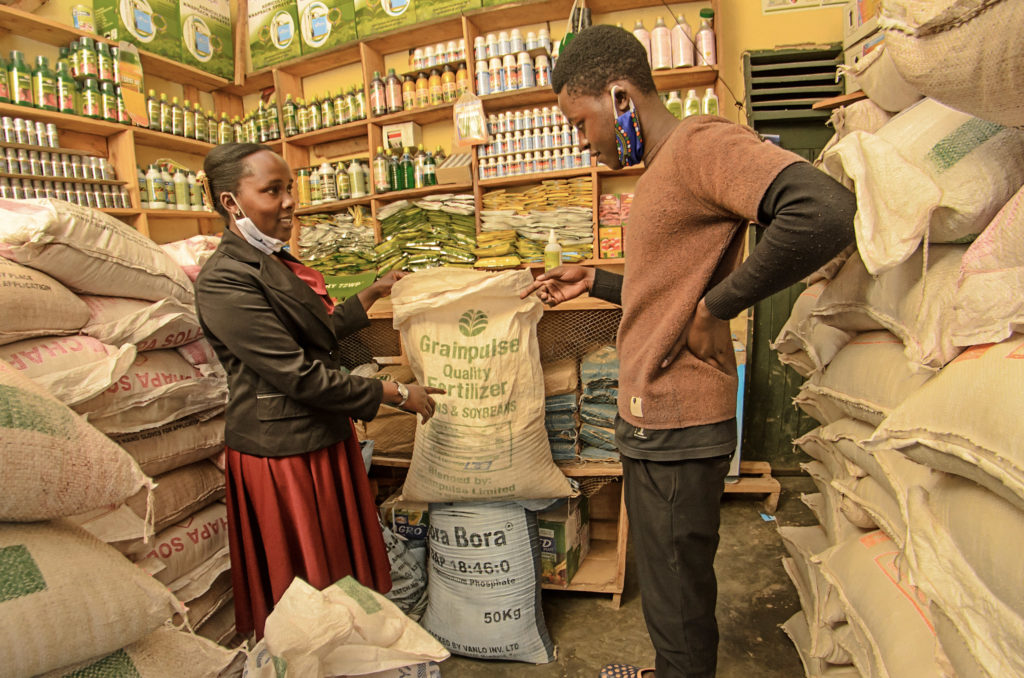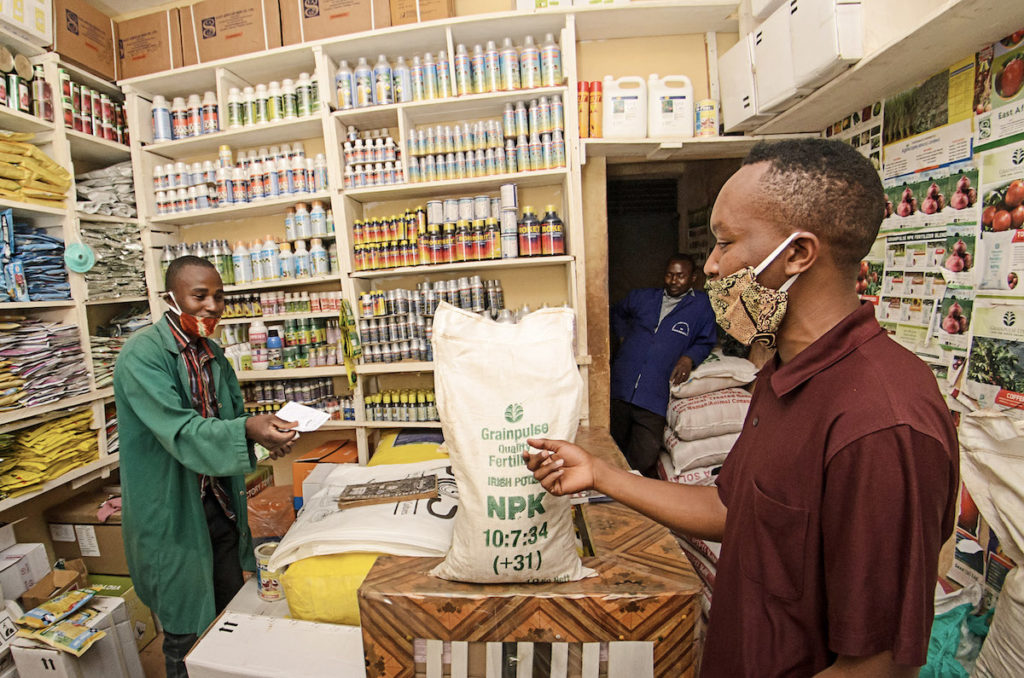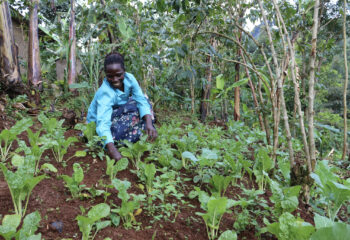
This blog is adapted from IFDC’s paper, “Fertilizer and Soil Health in Africa: The Role of Fertilizer in Building Soil Health to Sustain Farming and Address Climate Change.”
In agriculture, soil degradation is primarily driven by poor fertilizer application and suboptimal management of nutrients, which leads to nutrient losses and a decline in soil’s biological, chemical, and physical quality. This reduces its capacity to support agricultural production and environmental functions. Soil degradation is a major issue affecting crop productivity and the prevalence of malnutrition in sub-Saharan Africa (SSA). The subcontinent loses over U.S. $4 billion worth of soil nutrients each year. It remains the only area in the world to experience negative nutrient balances, which continue to worsen yearly and have stagnated the region’s ability to produce nutritious food.
Mineral fertilizers play an essential role in raising crop yields. They replace the nutrients that plants mine from the soil as they grow. When farmers use an appropriate amount of the right kind of fertilizer, in tandem with proper management practices, for their crops and soils, they can grow more food on less land. This increase in yields allows farmers to grow enough food without expanding into uncultivated areas, halting and potentially reversing deforestation and conserving biodiversity.
Incorrect use of fertilizer leads to poor use efficiency and nutrient uptake. The underlying reasons for poor fertilizer use efficiency are complex but include: (1) suboptimal crop management in terms of sowing time, crop density, timely weeding, etc.; (2) late application of fertilizer, often caused by issues with timely access to inputs; (3) an inappropriate fertilizer formulation for the local conditions, which causes over- or underapplication of nutrients; (4) lack of training in soil fertility management; and (5) poor soil health.
To successfully address soil degradation in SSA, we must improve nutrient use efficiencies. At current fertilizer application rates in the region, soils continue to lose nutrients faster than they are replaced, which leads to substantial soil degradation and declining soil health—and left unchecked, this will eventually result in nonresponsive soils.
Food security can only be achieved in healthy, fertile, and productive soils. Therefore, agricultural intensification in SSA should be supported by science-based agronomic approaches to improve soil fertility at scale, enhance the affordability and availability of fertilizers, offer targeted fertilizer recommendations tailored to localized variations in soil fertility and the environment, and provide incentives for farmers to invest in their soils.

Making the Most with the Least Fertilizer
The social, economic, and environmental sustainability outcomes of fertilizer use in crop production systems are dictated by a delicate balance of needs: increasing productivity, optimizing economic returns, minimizing adverse environmental effects, and maintaining soil health and ecosystem services. Judicious fertilizer use is crucial to fertilizer’s success. This means that fertilizer application must be tailored to conditions specific to each location to increase yields, profitability, and nutrient use efficiency. Agricultural intensification in SSA should be supported by science-based agronomic approaches to improve soil fertility at scale, enhance the affordability and availability of fertilizers, spatially target fertilizer recommendations, and provide incentives for farmers to invest in their soils.
Several innovative approaches have been introduced to reduce the negative impacts of agriculture while increasing yields and sustainability; these approaches include transformational techniques such as the 4Rs of Nutrient Stewardship, the application of geographic information systems (GIS) data, and Integrated Soil Fertility Management (ISFM).
The 4Rs of Nutrient Stewardship—right source, right rate, right time, and right place—ensure that fertilizer is used appropriately and managed effectively and efficiently. Fertilizer use becomes affordable for smallholder farmers when crop yields increase significantly and fertilizer waste and runoff are minimized. According to a recent paper from IFDC, “Fertilizer and Soil Health in Africa,” yields are generally lower than expected when no fertilizer is applied, suggesting limitations associated with low soil nutrient availability in places like SSA. Even with low rainfall levels, opportunities exist to more than double crop productivity using fertilizers.

When GIS data is combined with regional and local knowledge, farmers can make informed decisions about the type and amount of fertilizer to use for their preferred crops. An ideal fertilizer recommendation allows farmers to achieve potential yields, maximize fertilizer use efficiency, and optimize economic returns while maintaining soil health over the long term. These approaches will maximize nutrient use efficiency and ensure that crop productivity increases in SSA can be achieved and sustained.
Additional approaches for reducing the impacts of agriculture on climate change while improving yields and soil health include microdosing and fertilizer deep placement.
Fertilizer alone is not enough; it should be combined with other crop, soil, and water management practices to improve soil health. ISFM combines the use of mineral fertilizers with organic inputs, quality seeds, improved germplasm, and good agricultural practices to optimize the agronomic efficiency of fertilizer and enhance soil health and productivity. The approach balances nutrient supply and demand, enhances nutrient use efficiency, and improves soil characteristics.

Overcoming Barriers to Efficient Fertilizer Use
Fertilizer use can lead to negative environmental consequences if not managed properly. For example, excessive fertilizer use can lead to soil and water pollution, greenhouse gas emissions, and other environmental problems. Therefore, it is essential to use fertilizer in a way that maximizes its benefits while minimizing its negative environmental impacts.
To overcome barriers to efficient fertilizer use and encourage farmer adoption, IFDC recommends:
- Enhancing access to affordable and quality fertilizers.
The Feed the Future EnGRAIS project and its counterpart initiative, Feed the Future Senegal Dundël Suuf, aim to increase the availability and use of fertilizers that are appropriate and affordable for smallholder farmers in West Africa.
- Providing extension services and agricultural advisory services that include good soil health management and agronomic practices, water management, weather-crop insurance, and market information.
The BRIGHT project is building the resilience of 100,000 highland farm households in Uganda by introducing appropriate climate-smart agriculture techniques and technologies to strengthen local farming systems, ensure natural resource conservation, and support the development of strategic value chains.
- Bundling fertilizer use promotion programs with soil conservation and organic matter management to provide better incentives for farmers to use fertilizer.
The PAGRIS project aims to improve the availability of, access to, and utilization of context-specific fertilizer products and techniques for more than 1.2 million farming households in Burundi by building the capacity of agricultural knowledge institutes, identifying and assisting in cost-effective organo-mineral fertilizer blend production, and supporting the national fertilizer subsidy program.
- Creating a favorable, enabling environment through targeted policy interventions that support the delivery of broadened and digitally enabled fertilizer management recommendations and the creation of conditions that allow smallholder farmers to implement these recommendations at scale.
The SOILS Consortium seeks to amplify several pathways to achieving the overall goal of generating and promoting practical, profitable, and scale-appropriate soil and land use management technologies and recommendations for healthier and productive farming systems globally.
- Redesigning fertilizer subsidies to make them smarter with respect to soil health management.
The PARSEN project is working with the Government of Niger to implement a targeted, traceable fertilizer subsidy.
- Facilitating access to data and analytics to monitor the status of and changes in soil health and collecting and analyzing medium- to long-term data on the impact of farmer practices on soil health properties.
The AfricaFertilizer initiative is the leading provider of fertilizer data for Africa to support market transparency, improved decision-making, and a more prosperous agriculture sector.
- Providing policymakers with reliable estimates of soil health benefits on environmental outcomes and ecosystem services, including the benefits of land spared from agriculture through sustainable intensification.
The Feed the Future Bangladesh Climate-Smart Agriculture project is working to enhance public use of evidence regarding the benefits of climate-smart agriculture technologies and practices.
By implementing these measures, farmers can be encouraged to adopt fertilizer and other soil health management practices, leading to improved soil health, increased crop productivity, and enhanced food security. With judicious fertilizer use, enhancements in soil health, crop productivity, and food security benefit not only farmers, but people across the globe. By increasing the nutritional capacity of our soils with fertilizer, we can ensure that nutritious, healthy food reaches individuals around the world.




